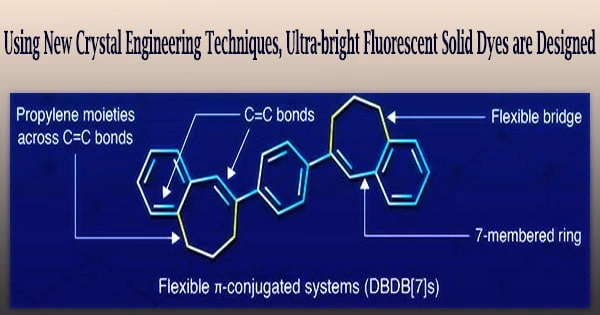According to a new study, bridging crystal structures may hold the key to permitting monomeric emission and gaining access to innovative crystalline systems when it comes to creating ultrabright solid-state fluorescent materials.
An innovative crystal engineering study was used in the study by a research team from Tokyo Institute of Technology to create ultrabright fluorescent dyes using di-bridged distyrylbenzenes (DSBs) with flexible alkylene bridges. The research’s findings will undoubtedly have a significant impact on the development of photofunctional materials.
Fluorescent solid organic dyes have a variety of uses, including lasers, bioimaging, organic light-emitting diode (OLED) displays, and functional nanomaterials. These compounds exhibit outstanding adaptability, versatile molecular architectures, and outstanding processability.
Enhancing these solid-state fluorescent dyes’ luminous qualities, crystallinities, and emission colors is a crucial area of research in the field, particularly for the creation of cutting-edge OLEDs. However, there are three main barriers that prevent this from happening.
One, the majority of fluorescent dyes exhibit concentration quenching in the solid state (a decrease in fluorescence when the concentration of the fluorescing molecule surpasses a particular level). Two: the propensity of dye molecules to group together in the solid state, where the ensuing intermolecular electrical interactions cause fluorescence of various colors.
Three, there is a lack of crystal design techniques that can guarantee monomeric emission, or more specifically, emissions of a single wavelength, such as color.
To solve this, a research team from the Tokyo Institute of Technology under the direction of Associate Professor Gen-ichi Konishi created a unique crystal design technique utilizing flexible molecular bridges.
A typical approach to crystal design for fluorescent solid dyes is the steric-hindrance-based strategy, where we manipulate the bulk of a molecule to cause congestion around the reactive atoms and suppress intermolecular interactions. But a frequent disadvantage of this approach is an increased distance between the chromophores (fluorescent molecules). Our design strategy successfully avoids this side effect.
Gen-ichi Konishi
The production of highly luminous monomeric emissive di-bridged distyrylbenzenes (DSBs) with regulated electrical characteristics and luminescence is described in the paper, which was published in Chemistry A European Journal.
“A typical approach to crystal design for fluorescent solid dyes is the steric-hindrance-based strategy, where we manipulate the bulk of a molecule to cause congestion around the reactive atoms and suppress intermolecular interactions. But a frequent disadvantage of this approach is an increased distance between the chromophores (fluorescent molecules). Our design strategy successfully avoids this side effect,” explains Associate Prof. Konishi.
The research team created DBDBs, a very dense crystalline structure, for this study. As -conjugated systems, DSBs and DBDBs are organic compounds with structures that alternate between single bonds (C-C) and double bonds (C=C).
As a bridge molecule between the six-membered rings on either side of the double bonds in the DSB structure, the scientists added an organic functional group known as propylene. This inclusion resulted in the formation of a novel, compact crystal structure with reduced chromophore distances and suppressed intermolecular interactions.
“Essentially, the introduction of seven-membered (after bridging) rings to the DSB core created a moderate distortion and steric hindrance in the π-plane of DSB, which allowed us to control the molecular arrangement without increasing the crystal density,” says Associate. Prof. Konishi.
Further research on the photophysical characteristics of DBDB[7]s revealed that monomeric emission in the solid state was assisted by the bridge molecules’ modest size. They observed that DBDB[7]s emit comparable colors in both solid-state and unaggregated dilute solution and were extremely brilliant with a high quantum yield.
“The bridged DSB crystal structure described in our study allows access to novel crystalline systems,” concludes Associate Prof. Konishi. “Our strategy has far-reaching implications for how we approach the design of photo functional molecular crystals.”





